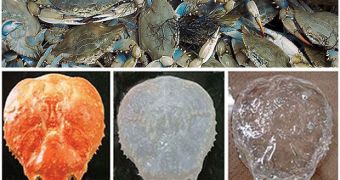Translucent chitin isn't exactly something one would assume to exist, especially if people have any idea what chitin is, but there definitely exists, right now, a transparent crab shell.
The reason for the existence of such a thing is because biologists from the university of Kyoto decided to turn a regular crab shell into a transparent one.
An entire dead crab was taken by Muhammad Iftekhar Shams and his team at Kyoto University and treated to a brew of acids and chemicals: hydrochloric acid, sodium hydroxide and ethanol.
This completely emptied the crab of fats, pigments, proteins, lipids and minerals.
After that was done, the crab, or what was left of it, was immersed in an acrylic resin monomer, at which point the process of Polymerisation began.
Since the crab was already transparent when this final step was taken, the monomer molecules reacted together and formed polymer chains.
The end result was, as sci fi as it sounds, a completely transparent crab, or recreation of a crab.
It is the researchers' belief that such a thing can reveal how truly bendable displays may be created.
Also, the same research could shed light on other flat panel displays as well as new solar cells.
"This class of materials is an interesting candidate for transparent substrates in next-generation electronic devices such as flexible displays and solar cells," the team stated in the paper's abstract—published by the Royal Society of Chemistry and located here.
The primary asset of the material is that, when heated up, it doesn't lose its stability or expand, being ten times more resistant to heat than glass-fiber epoxies.
This, along with the high light transmittance, is what makes it such a promising candidate for solar cells and bendable panels molded into shapes.
Hopefully, if this takes off, there won't be too much conflict with nature activists. Chitin is abundant in nature, produced by insects, mollusk radulas, arthropod exoskeletons, fungi cell walls and cephalopod beaks, not just crabs.

 14 DAY TRIAL //
14 DAY TRIAL //